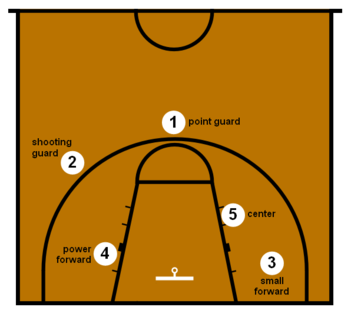User:TheKrakenllk
| This is a draft article. It is a work in progress open to editing by anyone. Please ensure core content policies are met before publishing it as a live Wikipedia article at Positions in basketball. Find sources: Google (books · news · scholar · free images · WP refs) · FENS · JSTOR · TWL Last edited by Dicklyon (talk | contribs) 17 months ago. (Update) |

- 1–Point guard
- 2–Shooting guard
- 3– Small forward
- 4–Power forward
- 5–Center
Basketball is a game played between two teams of five players each on a rectangular court, usually indoors. Each team tries to score by tossing the ball through the opponent's goal, an elevated horizontal hoop and net called a basket.The Positions in basketball are Point guard, Shooting guard, Small forward, Power forward (basketball),and the center. These are all the players on both teams of the court. The starters are called Backups.
Point guard
[edit]- The point Guard, also known as the one or the point, is one of the 5 positions in a regulation basketball game. A point Guard has perhaps the most specialized role of any position Point guards are expected to run the team's offense by controlling the ball and making sure that it gets to the right player at the right time. Above all, the point guard must understand and accept their coach's game PlanA point guard, like other player positions in basketball, specializes in certain skills. Their primary job is to facilitate scoring opportunities for their team, or sometimes for themselves. Lee Rose has described a point guard as a coach on the floor, who can handle and distribute the ball to teammates. This involves setting up plays on the court, getting the ball to the teammate in the best position to score, and controlling the tempo of the game. A Point guard should know when and how to instigate a fast break and when and how to initiate the more deliberate sets. Point guards are expected to be vocal floor leaders. A point guard needs always to have in mind the times on the shot clock and the game clock, the score, the numbers of remaining Time-outs for both teams.
After an opponent scores, it is typically the point guard who brings the ball down court to begin an Offensive play. Passing skills, ball handling, and court vision are crucial. Speed is important; a speedy point guard is better able to create separation and space off the dribble, giving themselves room to work. Point guards are often valued more for their assist totals than for their scoring. Another major evaluation factor is assist-to-turnover ratio, which reflects the decision-making skills of the player. Still, a first-rate point guard should also have a reasonably effective jump shot.
Among the taller players who have enjoyed success at the position is Ben Simmons, who at 6’ 10” won the 2018 National Basketball Association Rookie of the Year Award. Behind him is Magic Johnson, who at 6’ 9” (2.06 m) won the National Basketball Association Most Valuable Player Award three times in his career. Other point guards who have been named NBA MVP include Bob Cousy, Oscar Robertson, Derrick Rose, and Russell Westbrook, and two-time winners Steve Nash and Stephen Curry. In the NBA, point guards generally range from 6' 2" (1.88 m) to 6' 4" (1.93 m) whereas in the WNBA, point guards are usually 5' 8" (1.73 m) or shorter. Having above-average size (height, muscle) is considered advantageous, although size is secondary to situational awareness, speed, quickness, and ball handling skills. At 5' 3" the shortest player in NBA history, Muggsy Bogues enjoyed a 14 year career as a point guard. Shorter players tend to be better dribblers since they are closer to the floor, and thus have better control of the ball while dribbling.
